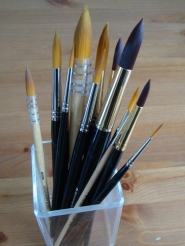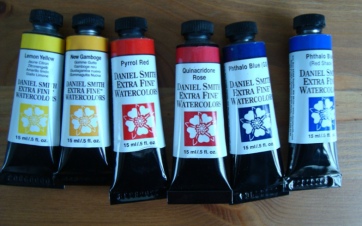Many watercolours are not vegan, and in the case of some brands, NONE of their paints are vegan, because they contain ox gall (obtained from the stomachs of cows). In other cases, it’s the pigment that’s animal-derived.
Here’s what I know about the big brands:
•Winsor & Newton
None of their Artists’ Quality Watercolours are vegan because they contain ox gall. Their student range–Cotman–are all vegan, apart from Viridian Hue, Raw Umber, and Ivory Black.
I’m pleased that (most of) the Cotman paints are vegan, since my son uses them. But they’re not high enough quality, nor do they offer enough of a colour spectrum for me.
•Schmincke
These paints contain ox gall.
•Jackson’s Professional Watercolours
I rang them. Their paints contain both ox gall and honey.
•Holbein
These paints are animal-free, except for the ivory black, which is made from charred animal bones. Sadly, this is not a brand I would use, because according to handprint.com the paints contain fillers, have lightfastness issues, and pigment quality is just not as good as other brands.
•Daler-Rowney Artists’ Watercolours
Animal-friendly apart from “bone black”. Sadly, another brand I wouldn’t use as these paints have brighteners, fillers, and lightfastness issues.
•Daniel Smith
Right…Daniel Smith is a favourite of mine; they’re fabulous. I emailed them to ask if their watercolours contain any animal-derived ingredients, and this is the reply I got:
“Hi Michelle, They don’t. We have our MSDS sheets listed on our website too- if that helps with your research.”
I wasn’t really satisfied with this response as I know for sure that at least one of their pigments (ivory black) contains charred animal bones. So I emailed again:
“I’m sorry, I can’t seem to find the ingredients (apart from the metals & pigments) on the MSDS. Can you please tell me what is used as the brightener (if used), the binder, the plasticizer, the humectant, the extender (or filler, if used), and the dispersant? And if glycerin is used, whether it is plant or animal-based? I plan to sell my paintings to raise money for animal sanctuaries, and I’d really like to be able to label them as vegan, so I really appreciate your help and any information you can provide. Thank you, Michelle”
This was the response:
“Hi Michelle, Just pigment and gum arabic. We don’t use fillers.”
I still wasn’t happy, so I called them. The person I spoke to assured me that the paints do not contain ox gall and only contain gum arabic (which is vegan) and pigment.
Despite all of this, I’m still not convinced. See this post for why: https://overflowingpalette.wordpress.com/2016/04/26/vegan-art-supplies-part-3-corrections/
•Colors of Nature
 Each paint is made from a single, natural earth pigment, and is comprised of at least 30% pigment. They’re lightfast, solvent-free, petrol chemical-free, non-toxic, vegan, natural, and completely cruelty-free. However, as far as I’m aware, there is no UK distributor. I was sent a set of these to review a while back, and here’s what I made of them:
Each paint is made from a single, natural earth pigment, and is comprised of at least 30% pigment. They’re lightfast, solvent-free, petrol chemical-free, non-toxic, vegan, natural, and completely cruelty-free. However, as far as I’m aware, there is no UK distributor. I was sent a set of these to review a while back, and here’s what I made of them:
Upon opening the paints, I noticed a slightly sweet smell—not unpleasant—but very different from traditional watercolours.
The paints behave much like other watercolours, although I’d say they’re a little stickier. They do, however, dissolve easier in water, and I was never left with any bits of neat paint smeared across the paper.
They spread well, granulate beautifully, and do provide a lot of coverage. The colours are not at all chalky. I feel the quality is as good as professional watercolours.
Due to Colors of Nature’s commitment to provide completely natural, non-toxic, eco-friendly, cruelty-free paints, the palette is somewhat limited, but they are working to add more colours to their range.
Earth pigments aren’t as transparent as some other colours, and because of that, along with the limited colour range, mixing is a little tricky.
I am a lover of bright colours. I adore quinacridones. I paint fuchsia poppies and emerald chickens. I layer colours and do a lot of wet-in-wet work. I am also an artist of very limited ability, and I just couldn’t get these colours to do what I wanted. Other far more talented artists have done beautiful things with these paints. You can view some of their amazing artwork here: http://www.colorsofnature.com/gallery1.html
I think these paints offer such a great alternative, and although there aren’t yet enough bright colours to satisfy me, for artists who paint landscapes, nature scenes, and portraits, these are perfect.
Pigments
Most pigments are either synthetic, mineral, or from metals; very few are animal-derived. A simple search clears up the matter. You can’t look up the pigment name, you need the pigment ID. For example, I assumed that Daniel Smith’s “Carmine” was from cochineal, but it’s not. Cochineal is no longer used in watercolours because it is not lightfast.
These pigments are animal-based:
•pbk9 = charred animal bones. Found in blacks (“Ivory black”) and browns (particularly sepia).
•NR4 = cochineal. On the off-chance it is present.
•NY20 = extracted from the urine of cows fed mango leaves. I’ve not seen this pigment in any supplies, and it’s banned in England.
There may be more, and when I find them, I’ll add them to this list. A great resource is http://www.webexhibits.org/pigments/.
Other Media
According to online investigations:
•Daler-Rowney FW acrylic inks are all vegan. These inks are excellent.
•ALL Faber-Castell products are vegan apart from a set of crayons.
•Caran d’Ache NeoColour II water-soluble crayons are vegan.
So, what am I using now?
 These brushes are all from Rosemary & Co. They are the best synthetic brushes I’ve tried so far. They hold nearly as much water as the animal hair brushes and are just as soft. They also point better. Her prices and customer service are second to none. I placed 3 orders in total and received my items the next day, or day after if I ordered later in the day.
These brushes are all from Rosemary & Co. They are the best synthetic brushes I’ve tried so far. They hold nearly as much water as the animal hair brushes and are just as soft. They also point better. Her prices and customer service are second to none. I placed 3 orders in total and received my items the next day, or day after if I ordered later in the day.

These are my Daniel Smith watercolours. I’ve purchased a basic, split-primary palette of:
•lemon yellow (cool)
•new gamboge (warm)
•quinacridone rose (cool)
•pyrrol red (warm)
•phthalo blue green shade (cool)
•phthalo blue red shade (warm)
I have sold the Daniel Smith paints, which I suspect are not vegan and replaced them with Holbein. (See: https://overflowingpalette.wordpress.com/2016/04/26/vegan-art-supplies-part-3-corrections/)
And, of course, I’m using the Fabriano Artistico paper.

Such an interesting post